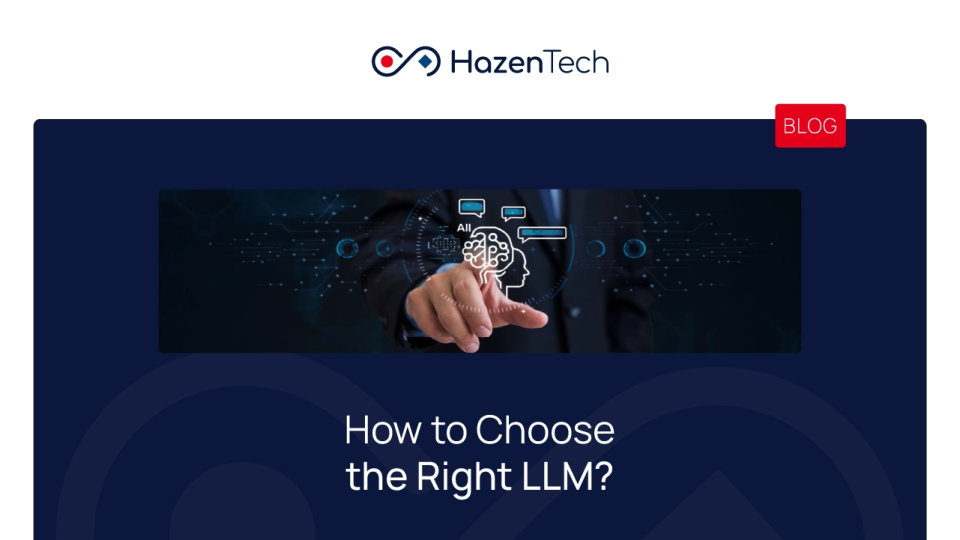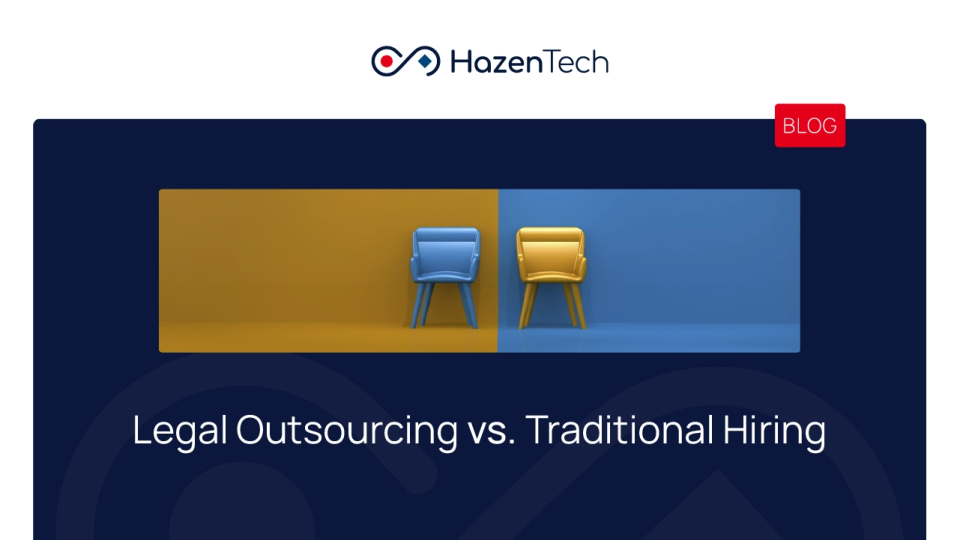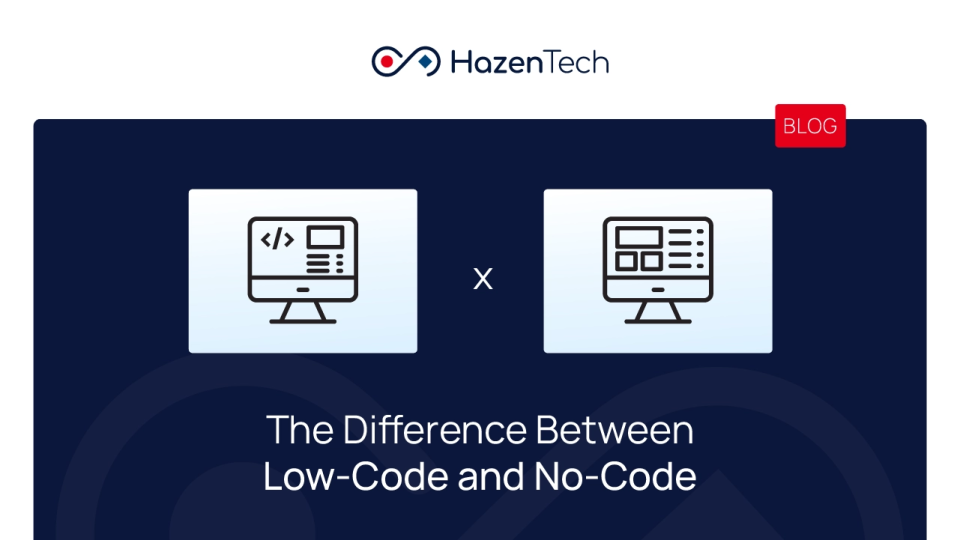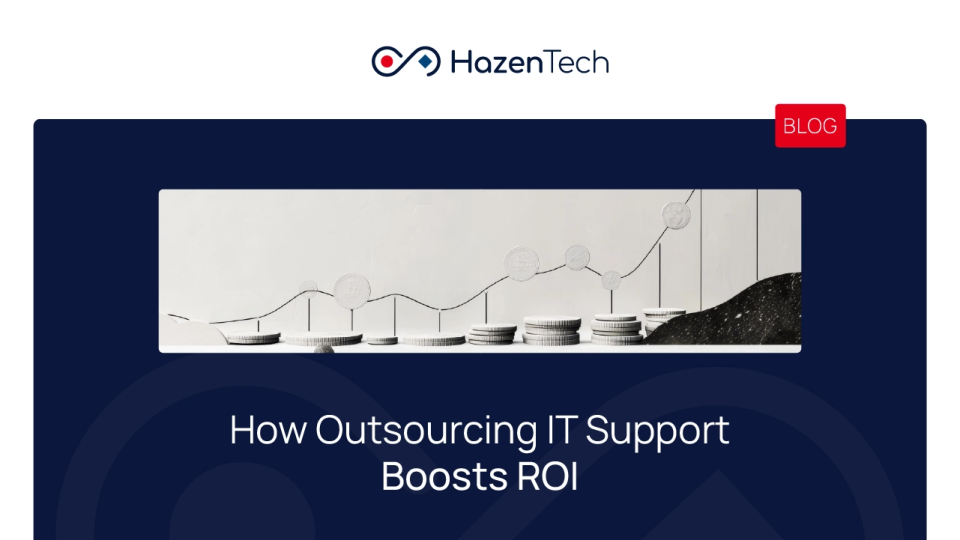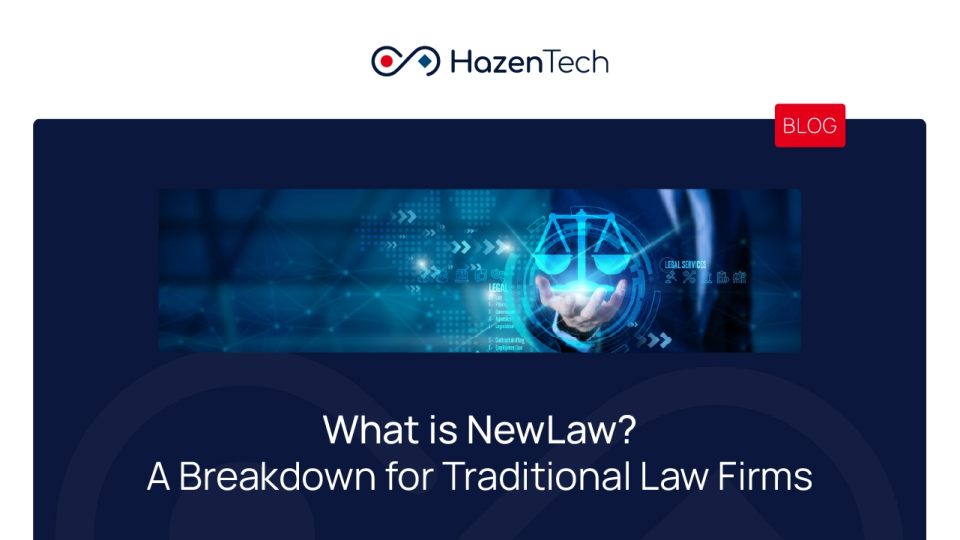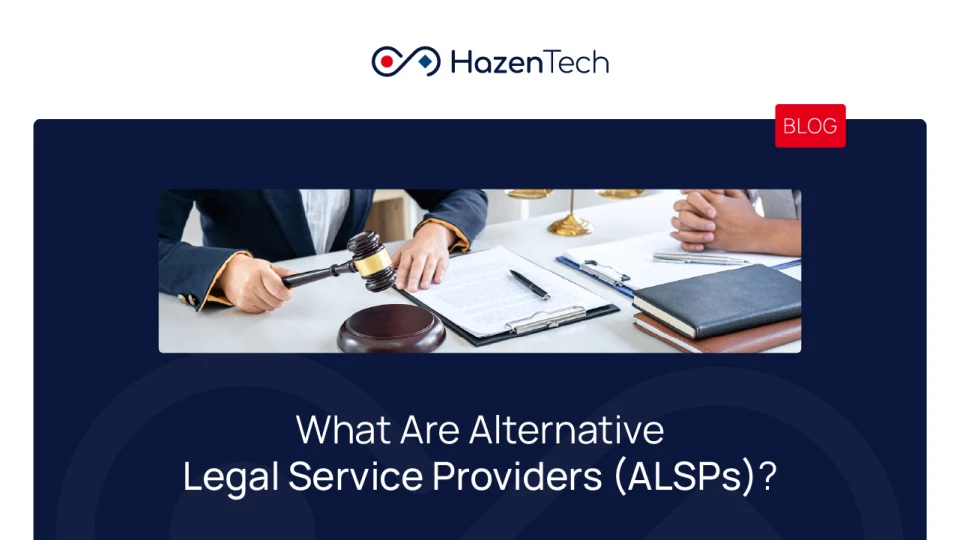Choosing the right large language model (LLM) isn’t as simple as picking the one with the flashiest name or highest parameter count. The best model depends on what you’re trying to achieve, and that’s where most teams trip. Every LLM looks impressive in benchmarks, but performance in your actual environment can tell a completely different story.
“Should we use an open-source model like Llama 3 or a commercial one like GPT-4 or Claude 3?” That’s something almost every other law firm, tech company, and startup thinks about. Each option has its strengths, but not all of them align with your data security, cost tolerance, or task complexity.
So, it’s not always about choosing the smartest or the most widely accepted model. You should be looking for the one that fits your use case, data, and control requirements. That’s why evaluation should go beyond accuracy. You have to consider inference cost, latency, fine-tuning potential, and alignment with compliance.
In simpler terms, an LLM is not a product that you can buy and get the job done. It includes establishing an ecosystem that works in perfect balance. And unless you define what you need it for, like legal research, document drafting, chat support, or summarization, even the most advanced model will fail to deliver consistent value.
This guide breaks the process down into simple steps. You’ll learn how to define your goals, test performance, and make sense of the endless noise surrounding model claims.
Step 1: Define Your Use Case and Metrics
Choosing the right LLM starts with a brutally honest question: “What exactly are you trying to do with it?”
Every model behaves differently depending on the task, and most “model comparisons” online ignore that context entirely.
If your goal is document summarization, you’ll care about coherence, compression accuracy, and factual consistency. But if you’re using LLMs for legal research or code generation, precision, traceability, and logical reasoning matter far more than fluency. A model that sounds smart isn’t always smart.
Here’s a tip: define quantifiable metrics before you test a single prompt. Evaluation has two layers:
- Quantitative metrics, such as ROUGE, BLEU, F1, or accuracy, for structured tasks.
- Qualitative metrics, like reasoning depth, citation reliability, and contextual understanding.
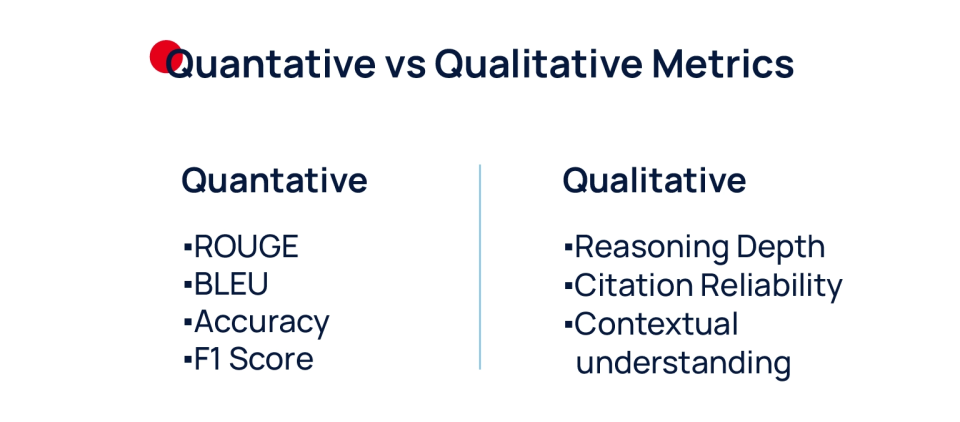
For example, if your use case involves compliance checks or contract reviews, you can’t rely solely on accuracy. You’ll need to track false positives, hallucination frequency, and explainability since a single incorrect clause could cost more than the entire model subscription.
The model’s “best” performance depends on your domain constraints. A finance firm’s ideal LLM isn’t the same as a creative studio’s. You’ll want a model that fits your data type, latency tolerance, cost ceiling, and regulatory requirements, which makes it a pretty broad domain.
Quick advice: Be specific. The tighter your definition of success, the faster you’ll identify which LLM actually works for you.
Step 2: Prepare the Data and Generate Outputs
Once you’ve defined your evaluation task, the next step is to prepare a dataset that clearly represents the challenges your LLM will face. Remember, your model is only as smart as the data you test it on.
Start with a diverse and domain-relevant dataset. For general reasoning or summarization tasks, open datasets like MMLU, TruthfulQA, or GSM8K can be helpful. But for niche applications like legal document review, financial analysis, or customer chat, you’ll need custom datasets built from your own corpus. Ideally, that includes a mix of prompts, structured data, and long-context inputs.
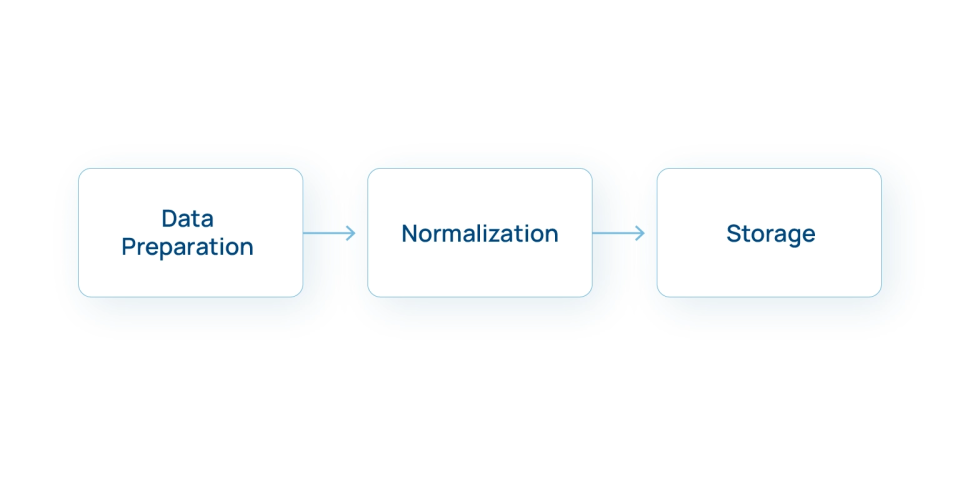
Then comes normalization and quality control. Remove bias, duplicates, and ambiguous samples. Keep your dataset balanced across different difficulty levels (easy, medium, hard) so your evaluation doesn’t favor models that overfit to simple tasks.
Once your data is set, feed it to multiple LLMs under identical conditions. Use consistent prompt templates, temperature, and max token limits. Even a slight variation can skew results.
Finally, store all generated outputs with metadata (model name, version, date, system prompt). This step is crucial for auditability and reproducibility, especially if you’ll re-run tests after model updates.
Step 3: Automate Evaluation with a Judge LLM
Evaluating outputs manually works fine when you’re testing a few dozen prompts. But once you scale past a few hundred, it becomes slow, inconsistent, and prone to bias. That’s where you use the Judge LLM: a model that scores other models.
A Judge LLM comes in handy when you’re not in the mood to evaluate responses generated by different LLMs. You can simply let Judge LLM handle it. It evaluates responses against your criteria (accuracy, reasoning depth, coherence, factuality, tone, or safety). Instead of relying on human raters, you use another model to grade responses in bulk using structured scoring prompts.

The trick is in prompt design. For instance, you might ask Judge LLM:
“On a scale of 1 to 10, how factual and contextually relevant is the following response?”
You can also make it multi-dimensional, grading clarity, completeness, and factual alignment separately.
For transparency, always keep the same evaluation prompt and temperature for each scoring run. Suppose you change the Judge model later, like switching from GPT-4o to Claude 3.5, record that version too. Remember, consistency matters a lot when you’re comparing models over time.
Some teams go a step further and use ensemble judging, where multiple LLMs evaluate the same output and their scores are averaged. It’s a more reliable approach that reduces the bias of a single model.
Step 4: Analyze, Visualize, and Interpret
Running tests is the easy part. The real value shows up when you analyze the scores and figure out what the numbers actually mean. A model with a higher average score doesn’t automatically win. You need to understand why it performed better, where it struggled, and how consistent it was across different task types.
Start with the basics:
Mean, median, variance, and outliers.
If a model gives strong results on simple prompts but collapses on edge cases, its average will look fine, but the variance exposes the instability. That’s the kind of nuance most teams miss when they only glance at headline numbers.
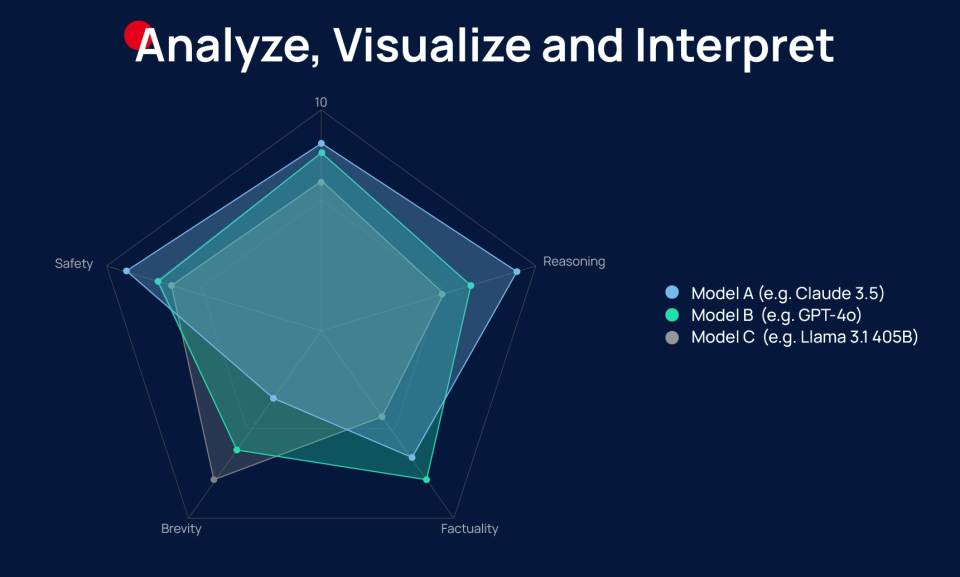
Then look at per-category performance.
Maybe Model X writes clean summaries but fails at retrieval-rich queries. Maybe Model Y is great at reasoning, but gets verbose in short-form tasks. Patterns like these help you match models to workloads instead of relying on generic benchmarks.
Visuals make this part much easier. A couple of simple charts (score distribution, difficulty curves, or radar plots) instantly show you how models differ. Even a basic scatter plot comparing “accuracy vs. hallucinations” can reveal more than a 10-page report.
Interpretation is the final step. Ask:
- What caused the gaps?
- Are the failures due to model limitations, data quality, or prompt design?
- Does the performance justify the cost?
Once you break results down like this, choosing the right LLM becomes less of a gamble and more of a measured decision.
Step 5: Iterate and Scale Up
Sadly, model evaluation isn’t a one-time job. You’ll constantly need to refine, retest, tweak prompts, rebalance datasets, and repeat. That loop matters because every LLM behaves differently once you push it beyond a small test batch. A model that looks solid on 200 prompts might fall apart on 20,000.
Start small, but don’t stay small.
Once you’re confident your evaluation setup works, scale it to thousands of test cases. That’s where you’ll see patterns you couldn’t catch earlier; Things like degradation under longer contexts, inconsistent reasoning chains, or performance dips on specific domains.
Then iterate.
If your results show weakness in reasoning, fold in more chain-of-thought prompts or structured tasks. Suppose the problem is factuality; beef up retrieval-heavy questions. The idea isn’t just to catch weaknesses, it’s to pressure-test models until you know precisely how they behave under real workloads.
Automation becomes essential at this point. Running large-scale evaluations manually will burn your team out before you even pick a model. Tools like custom eval pipelines, judge LLM scoring, and batch-processing scripts make scaling painless. You want a system that lets you rerun the entire suite with one command whenever you add a new model or update your data.

The final output of this stage is a feedback loop you can use repeatedly as models evolve, API versions change, and your workloads shift. Once this system is in place, choosing and maintaining the right LLM becomes a continuous, predictable process instead of a monthly fire drill.
Automate your business today and stay ahead with the power of artificial intelligence. HazenTech’s AI Development Services are just a click away. Book a free meeting and let our team take it from there.
Common Pitfalls to Avoid
Choosing an LLM gets messy when you skip the basics or trust vendor narratives a little too much. Most teams run into the same mistakes, and they cost time, money, or both. Here are the traps worth avoiding.
Testing models with unrealistic prompts
Prompts that never appear in real workflows give you inflated results. LLMs look great when everything is neatly formatted. Your evaluation needs the messy stuff like partial instructions, user typos, inconsistent context, and vague requests. That’s where failures hide.
Ignoring context-window behavior
A model might look sharp with short prompts and quietly fall apart once the context stretches past a few thousand tokens. A lot of teams don’t test long-context scenarios until production, and then wonder why responses feel shallow or incoherent. Always stress-test large inputs early.
Relying only on accuracy-style metrics
LLMs aren’t classification models. “Correct/incorrect” alone won’t show reasoning depth, consistency, or stability across variations. You need composite scoring for reasoning quality, structure, verbosity control, relevance to the instructions, and hallucination likelihood.
Assuming bigger equals better
Large models handle complex reasoning, sure, but they can also be slower, pricier, and overkill for simple tasks. A mid-sized model with clear boundaries often beats a giant model that generates more than you need. Always compare models by task, not hype.
Skipping cost modeling
Some firms forget to estimate the cost per 1,000 real requests. A model that looks great in testing may explode your budget in deployment. Benchmark latency, throughput, and total token usage before you commit.
Running small datasets and calling it a day
Tiny evaluation sets hide problems. Your confidence grows only when your dataset reflects all task types and difficulty levels across thousands of samples.
Preparing a Test Dataset
Your LLM is only as good as the data you feed it, and too many teams overlook this critical step. A well-constructed test dataset is the foundation of accurate evaluation. Without it, any comparisons between models are pretty much meaningless.
Start with a clear understanding of your task. Are you testing for summarization, factual accuracy, or contextual reasoning? Each use case will demand a different type of data. For example, if you’re evaluating a model for contract review, you’ll need datasets filled with real-world legal contracts, not generic documents.
Next, ensure your dataset is representative of the scenarios the LLM will encounter in production. A balanced dataset should include:
- Easy examples (baseline tests for the model),
- Moderate examples (tasks it should handle well),
- Hard examples (edge cases or low-resource tasks the model will struggle with).
This mix will prevent models from being overfitted to only the “easy” tasks and show you where they genuinely excel or falter. If your dataset is even slightly biased, it will skew results. For instance, if the data predominantly includes U.S.-based cases, the model might underperform on international tasks.
Finally, clean and preprocess your data. Remove irrelevant information, standardize formats, and eliminate errors. For example, in text generation tasks, fix any spelling issues, inconsistencies in terms, or noise that could interfere with scoring.
Your test dataset is your ground truth. It ensures that you’re not just measuring how the LLM performs in a vacuum, but how well it handles the complexity, diversity, and unpredictability of tasks.
How to Shortlist and Decide (Practical Framework)
After you’ve tested your LLMs, analyzed the data, and avoided common pitfalls, it’s time to make a decision. But how do you decide between models that each excel in different areas? That’s where a practical framework comes in.
The trick is to score each model based on a few critical factors:
- Performance fit: Does it meet your task requirements (accuracy, reasoning depth, etc.)?
- Cost efficiency: How does it scale in terms of cost per 1,000 tokens or queries?
- Ease of integration: How smoothly can you integrate this model into your systems? Does it fit within your current tech stack?
- Customization potential: Can you fine-tune the model easily for your specific use case, or does it require extensive work to adapt?
Create a Decision Matrix
Use a simple matrix to score each model based on these criteria. Here’s a quick example:
Criteria | Weight | Model A (Score) | Model B (Score) | Model C (Score) |
Performance (Accuracy, etc.) | 30% | 9/10 | 8/10 | 7/10 |
Cost Efficiency (per 1000 tokens) | 25% | 8/10 | 9/10 | 7/10 |
Ease of Integration | 20% | 7/10 | 8/10 | 9/10 |
Customization | 25% | 8/10 | 7/10 | 9/10 |
Score Calculation:
- Multiply each score by the weight (e.g., Performance: 9/10 x 30% = 2.7).
- Sum up the total for each model. The one with the highest total is your best option.
Red Flags to Watch Out For
- Overpromising vendors: If a model’s marketing sounds too good to be true, it probably is. Always trust your evaluation results, not the hype.
- Lack of transparency: If the model’s creators can’t explain its architecture, training data, or performance gaps, it’s a major red flag.
Final Step: Testing
Once you’ve shortlisted your top models, run them in real-world conditions. Use your live data, adjust your task parameters, and evaluate how well each performs under stress. This is the final step before full-scale deployment. Only then will you know if the model is truly the right fit.
Wrapping Up
Choosing the right LLM means making sure the model fits your use case, delivers reliable outputs, and scales with your needs.
The framework we’ve laid out, from defining your goals and evaluating with metrics to automating tests and creating a shortlist, ensures you can make a better decision.
Remember: LLM selection isn’t a one-off decision. It’s part of an ongoing evaluation. New models will come, your tasks will change, and fine-tuning will always be necessary. The goal is to create a system that adapts with you and aligns with your long-term objectives, rather than chasing the latest shiny thing.
